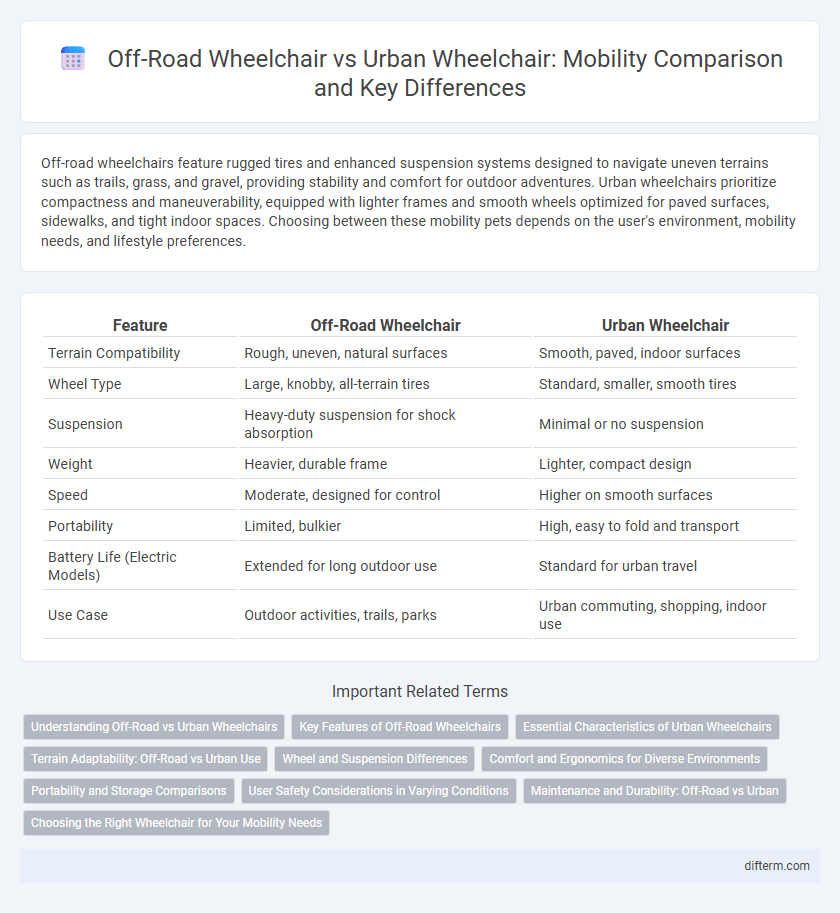Off-road wheelchairs feature rugged tires and enhanced suspension systems designed to navigate uneven terrains such as trails, grass, and gravel, providing stability and comfort for outdoor adventures. Urban wheelchairs prioritize compactness and maneuverability, equipped with lighter frames and smooth wheels optimized for paved surfaces, sidewalks, and tight indoor spaces. Choosing between these mobility pets depends on the user's environment, mobility needs, and lifestyle preferences.
Table of Comparison
| Feature | Off-Road Wheelchair | Urban Wheelchair |
|---|---|---|
| Terrain Compatibility | Rough, uneven, natural surfaces | Smooth, paved, indoor surfaces |
| Wheel Type | Large, knobby, all-terrain tires | Standard, smaller, smooth tires |
| Suspension | Heavy-duty suspension for shock absorption | Minimal or no suspension |
| Weight | Heavier, durable frame | Lighter, compact design |
| Speed | Moderate, designed for control | Higher on smooth surfaces |
| Portability | Limited, bulkier | High, easy to fold and transport |
| Battery Life (Electric Models) | Extended for long outdoor use | Standard for urban travel |
| Use Case | Outdoor activities, trails, parks | Urban commuting, shopping, indoor use |
Understanding Off-Road vs Urban Wheelchairs
Off-road wheelchairs feature rugged tires, reinforced frames, and advanced suspension systems designed to handle uneven terrain, dirt trails, and outdoor obstacles, offering superior stability and durability in natural environments. Urban wheelchairs prioritize maneuverability and compact design for smooth pavement, narrow doorways, and crowded spaces, often equipped with lighter materials and smaller wheels optimized for indoor and street use. Choosing between off-road and urban wheelchairs depends on the user's lifestyle, terrain accessibility, and mobility requirements, ensuring tailored support for diverse environments.
Key Features of Off-Road Wheelchairs
Off-road wheelchairs feature rugged, all-terrain tires and reinforced suspension systems designed to navigate uneven surfaces and challenging outdoor environments effectively. These wheelchairs often include high ground clearance, durable frames made from lightweight materials such as aluminum or titanium, and advanced traction control to enhance stability on dirt, gravel, and grass. Compared to urban wheelchairs, off-road models prioritize durability and adaptability to diverse terrains, making them ideal for users seeking mobility beyond paved urban settings.
Essential Characteristics of Urban Wheelchairs
Urban wheelchairs prioritize lightweight design and compact dimensions for enhanced maneuverability in tight spaces and crowded environments. They feature durable, puncture-resistant tires and smooth suspension systems to handle uneven pavements and curbs commonly found in city settings. Essential characteristics also include foldability for easy transport and advanced ergonomic seating to ensure comfort during extended use throughout urban areas.
Terrain Adaptability: Off-Road vs Urban Use
Off-road wheelchairs feature rugged, oversized tires and enhanced suspension systems designed for uneven, natural terrains like trails, gravel, and grass, ensuring stability and comfort. Urban wheelchairs prioritize maneuverability with smaller, smoother wheels optimized for flat, hard surfaces such as sidewalks, streets, and indoor environments. Terrain adaptability in off-road models accommodates rough outdoor conditions, while urban wheelchairs excel in navigating tight spaces and smooth pavement.
Wheel and Suspension Differences
Off-road wheelchairs feature larger, thicker wheels equipped with deep treads for enhanced traction on uneven terrains, paired with robust suspension systems that absorb shocks and maintain stability on rough trails. In contrast, urban wheelchairs have smaller, smoother wheels designed for maneuverability on flat surfaces and incorporate minimal suspension to prioritize lightweight handling and ease of navigation in confined spaces. The suspension on off-road models often includes advanced shock absorbers or spring systems, whereas urban variants rely mainly on rigid frames or basic cushioning for comfort.
Comfort and Ergonomics for Diverse Environments
Off-road wheelchairs feature reinforced suspension systems and larger, rugged tires designed to absorb shocks and enhance stability on uneven terrain, providing superior comfort during outdoor excursions. Urban wheelchairs prioritize lightweight frames and adjustable seating to support prolonged use on smooth surfaces, ensuring ergonomic posture for daily activities. Both types incorporate customizable cushioning and ergonomic controls tailored to diverse environments, maximizing user comfort and mobility efficiency.
Portability and Storage Comparisons
Off-road wheelchairs typically feature rugged, durable frames with larger, knobby tires designed for rough terrain, making them heavier and less compact for portability and storage compared to urban wheelchairs. Urban wheelchairs prioritize lightweight materials and foldable designs, allowing for easier transportation in vehicles and convenient storage in small spaces such as closets or car trunks. The trade-off between durability and portability means users must select based on their primary environment, with urban models excelling in maneuverability and storage efficiency.
User Safety Considerations in Varying Conditions
Off-road wheelchairs feature reinforced frames, larger rugged tires, and enhanced suspension systems designed to navigate uneven terrain, offering improved stability and shock absorption for user safety. Urban wheelchairs prioritize agility and compact design with smooth tires and responsive braking systems optimized for paved surfaces, reducing the risk of slips and falls in crowded environments. Selecting a wheelchair that matches the primary mobility context minimizes injury risk and ensures user confidence in varied conditions.
Maintenance and Durability: Off-Road vs Urban
Off-road wheelchairs feature reinforced frames and rugged tires designed to withstand harsh terrains, requiring regular maintenance of suspension systems and tire treads to ensure durability. Urban wheelchairs prioritize lightweight materials and smooth-rolling wheels, demanding frequent cleaning and occasional wheel alignment to maintain optimal performance. Both models benefit from routine inspections, but off-road wheelchairs generally exhibit higher resilience against environmental wear, making them suitable for varied outdoor conditions.
Choosing the Right Wheelchair for Your Mobility Needs
Selecting the right wheelchair depends on specific mobility requirements and environment, with off-road wheelchairs offering rugged tires, enhanced suspension, and durable frames suitable for uneven terrains like trails and gravel paths. Urban wheelchairs prioritize lightweight designs, compact dimensions, and smooth maneuverability tailored for indoor use, sidewalks, and crowded spaces. Evaluating factors such as terrain type, frequency of outdoor use, and user comfort ensures optimal mobility and independence.
Off-road wheelchair vs Urban wheelchair Infographic

 difterm.com
difterm.com